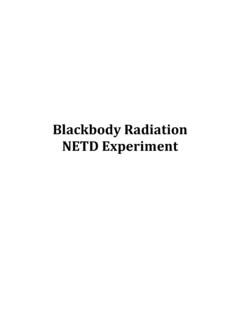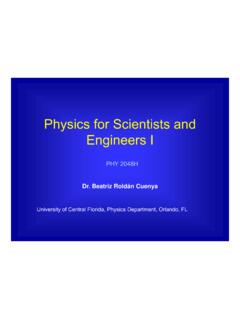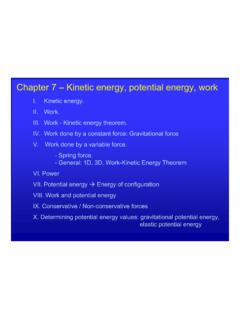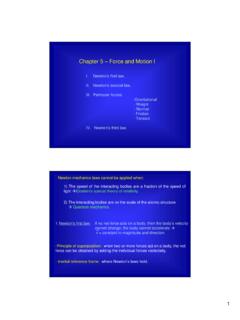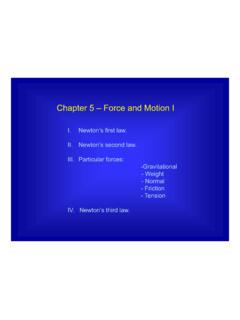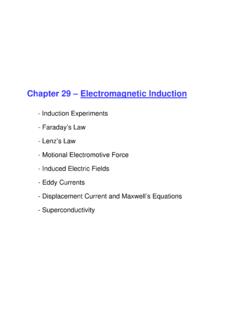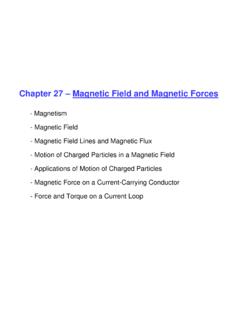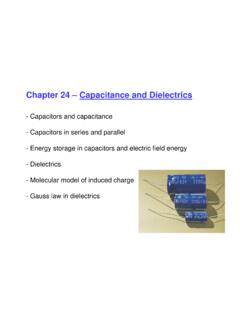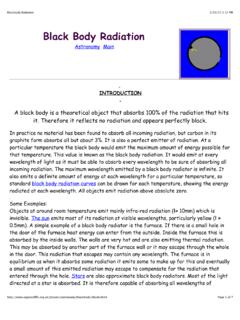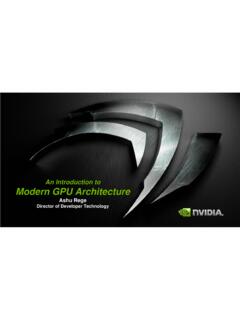Transcription of Nuclear Physics
1 Nuclear PhysicsNuclear Physics comprises the study of: The general properties of nuclei The particles contained in the nucleus The interaction between these particles Radioactivity and Nuclear reactions Practical applications of Nuclear phenomena:Medical radio-isotopes (imaging & therapy)Magnetic Resonance Imaging (MRI)Identification of materials (NAA, AMS)Dating of materialsPower generation (fusion and fission)Weapons of mass destruction (WMD)Properties of Nuclei Every atom contains at its center an extremely dense, positivelycharged nucleus, which is much smaller than the overall size ofthe atom, but contains most of its total nucleus is made of protons and neutronsProtons have positive electric chargeNeutrons have no electrical chargeIsotopes of an element have the same number of protonsbut different number of neutrons.
2 Isotopes have similar chemical properties, and different physical = number of protons (atomic number)N = number of neutronsA = Z+N (mass number) 168O AZOI sotope A Z N Atomic Mass (u) Abundance126C 12 6 6 136C 13 6 7 [The chemical atomic weight of carbon is u]146C 14 6 8 Radioactive[146C decays by -emission with Half-Life 5730 y] Nuclear Size and MassThe radii of most nuclei is given by the equation:R = R0A1/3R: radius of the nucleus, A: mass number, R0= mass of a nucleus is given by:m = A uu = (unified mass unit) Nuclear Density5626 Feis the most abundant isotope of iron ( ) R = (56)1/3= V = 4/3 R3= = (56) = = m / V = [Compare with the density of solid iron 7x103kg/m3]Since.
3 M = A u and R = R0A1/3 = m / V = u / (4/3 R03) constantAll nuclei have approximately the same density[Compare with inter-atomic separations ] Nuclear Binding EnergyThe total rest energy of the separated nucleons is greater than the rest energy of the difference is called the Binding Energy EBEBis a measure of the energy gained in formingthe nucleus from the individual nucleonsNote that AZM is the mass of the neutral atom containing thenucleus, and MHrefers to the mass of hydrogen (to balancethe Z electrons contained in AZM)EB= (Z MH+ N mN AZM)
4 C2 Binding Energy per NucleonThe binding energy per nucleon EB/A is nearly constant as a function of A, suggesting that the Nuclear force is saturated(a nucleon interacts only with its nearest neighbors).The Nuclear ForceThe force that binds together protons and neutrons inside the nucleus is called the Nuclear ForceSome characteristics of the Nuclear force are: It does not depend on charge It is very short range 10-15m It is much stronger than the electric force It is saturated (nucleons interact only with near neighbors) It favors formation of pairs of nucleons with opposite spinsWe do not have a simple equation to describe the Nuclear forceNuclear StabilityThe energy of a group of nucleons in a square well ( a reasonablefirst approximation to a nucleus) is smaller if Z N.
5 For largevalues of A we need N Z to compensate for the electric forceNuclear StabilityPlot of N vs. Z for known stable nuclides are indicated by the black nuclides decay by emission of particles, or electromagnetic radiation,in a process called radioactivityRadioactivityAlpha Decay:nuclei that are too large to be stable tend to decay byalpha decay, the emission of an alpha particle.[An alpha particle is the 4He nucleus, two protons and two neutrons]23892U 23490Th + Gamma Decay:the energy of internal motion (protons and neutronsin a nucleus is quantized.)
6 A nucleus has a set of allowed energy states (ground state and excited states) much like in an atom. Transitions betweenstates lead to the emission of very energeticelectromagnetic radiation called (gamma) rays23892U* 23892U + RadioactivityBeta Decay:consist in a) the emission of an electron -, b) the emission of a positron +, or c) electron ) Nuclides with neutron to proton ratio too large for stabilitytend to decay by conversion of a neutron into a proton, anelectron and an antineutrino: n p + -+ b) Nuclides with proton to neutron ratio too large for stabilitytend to decay by conversion of a proton into a neutron, apositron, and a neutrino: p n + ++ c) In certain cases an orbital electron can combine with a proton in the nucleus to form a neutron and a neutrino:p + - n + RadioactivityRadioactive decay is a statistical process.
7 There is now way to predict when an individual nucleus will decay. However, it ispossible to predict the decay rate of a group of constant is called the decay constant and can be interpretedas the probability per unit time that a nucleus will decayIf the initial number of radioactive nuclei at time t = 0 is N0,then the number of remaining nuclei at time t is given by:N(t) = N0exp(- t)RadioactivityThe Half-Life T1/2is the time required for the number of radioactive nuclei to decrease to half the initial value N0N0/2 = N0exp(- T1/2) T1/2= ln 2 / The mean lifetime Tmean, or lifetime, is the time required for the number of radioactive nuclei to decrease to 1/e of the initial value N0 Tmean= 1 Tmean= 1 / The number of decays per unit time dN/dt is the activity of a sample, and is measured in Curie (Ci)
8 1 Ci = T1/2 Tmean238U decay series14C DatingRadioactive 14C is continuously produced in the atmosphere[14N(n,p)14C, the neutrons being produced by cosmic rays].14C decays by -emission with half life T 1/2= 5730 y14C 14N + -+ The chemical activity of 14C is similar to that of 12C, so livingorganisms have the same 14C /12C ratio as in the atmosphere,which is about an organism dies it stops absorbing 14C, and the ratio 14C /12C decreases. Measurement of this ratio allows thecalculation of the time of death of the ReactionsA Nuclear reaction is a rearrangement of Nuclear components induced by particle bombardment42He + 147N 178O + 11H147N( ,p)178 ONuclear reactions are subject to the following conservation laws.
9 ChargeMomentum and angular momentumEnergyTotal number of nucleonsNuclear ReactionsSome Nuclear reactions release energy, while other reactions require input energy to proceedThe amount of energy released or absorbed in a Nuclear reaction(in the center of mass reference frame) is called the Q value, orreaction energy:If MA+ MB>MC+ MD Q > 0 exoergic reactionIf MA+ MB<MC+ MD Q < 0 endoergic reactionAn endoergic reaction will not proceed unless the incoming particleprovides the reaction energy Q (in CM)In a reaction: MA+ MB MC+ MDQ = (MA+ MB-MC-MD) c2 Particle Induced Nuclear Reactions:are used mostly for Nuclear Physics research, and for analytical purposesThe reaction 7Li(p, )4He can be used todetect Li in solids [1-2 MeV protons]Neutron Induced Nuclear ReactionsNuclear reactions induced by neutron bombardment are used.
10 A) In analytical techniques such as neutron activation analysisb) In the generation of energy by Fissionor FusionIt is convenient to distinguish between fast and slow neutronsFast neutron kinetic energy 1 MeVSlow neutron or thermal neutron kinetic energy ~ eVThe probability for a reaction to proceed or Cross Sectiondepends strongly on the energy of the neutronsNeutron Activation AnalysisVarious layers of a painting are revealed using NAALow energy neutrons are likely to be captured by nuclei, with emission of radiation from the excited nucleus, as in X(n, )
